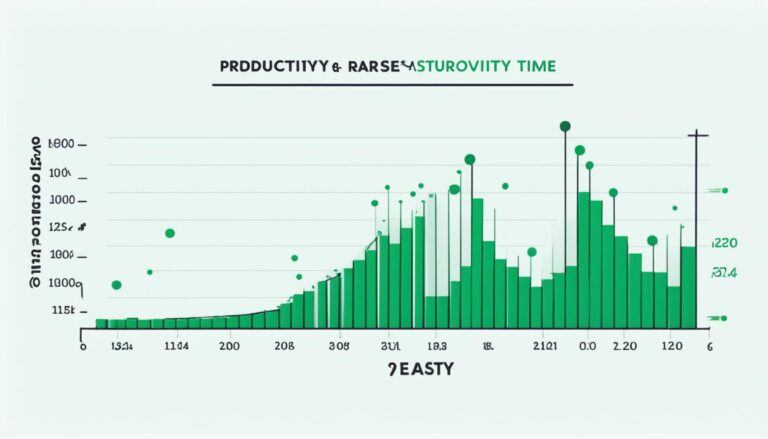Unlock the Mystery of the Productivity Paradox

Do you ever wonder why despite the technological advancements that have revolutionized the way we work, productivity growth seems to have hit a roadblock? Shouldn’t technology make us more efficient and productive? This is the productivity paradox – a puzzling phenomenon where the expansion of information and communication technologies fails to translate into substantial productivity gains.
But what exactly is causing this paradox? How does it impact organizational performance? And most importantly, how can we overcome it to unlock our true potential? Join us as we dive deep into the intricacies of the productivity paradox and uncover strategies to boost productivity in the modern workplace.
Key Takeaways:
- The productivity paradox refers to the discrepancy between technological advancements and productivity growth.
- The productivity paradox has implications for organizational performance and efficiency.
- Factors contributing to the productivity paradox include the misalignment between technological advancements and GDP growth.
- To overcome the productivity paradox, companies can implement workplace wellness programs, design offices that minimize distractions, provide employees with the necessary technology, offer office perks, and foster empowerment and engagement.
- The role of artificial intelligence in the productivity paradox and finding the balance between effectiveness and efficiency.
Understanding Productivity and its Paradox
Productivity is the key to success in the modern workplace. As a knowledge worker, you strive to achieve high levels of productivity to accomplish your goals efficiently and effectively. But what exactly is productivity, and why does it sometimes seem to defy logic?
In simple terms, productivity is a measure of how much value you can produce with the amount of labor you input. It is the ability to generate outputs that exceed the inputs required to produce them. In the workplace, productivity refers to your ability, as well as that of your team, to achieve desired outcomes.
Technological advancements have played a significant role in shaping productivity in recent years. With the advent of advanced tools and automated processes, knowledge workers like yourself now have the potential to accomplish more in a single day than ever before. This means that the barriers of time and limited resources are gradually being overcome through the power of technology.
However, this is where the productivity paradox comes into play. Despite the remarkable advancements in technology, overall productivity growth often fails to keep pace with the rate of technological advancement. It’s a puzzling phenomenon that has perplexed researchers and corporate leaders alike.
So why does this paradox exist?
The productivity paradox surfaces when the potential productivity gains that should arise from technological advancements do not fully materialize across industries and sectors. While individual knowledge workers may experience increased productivity due to improved technology, the collective productivity growth does not align with the rapid pace of technological progress.
This disconnect between technology and productivity growth is a matter of concern for organizations seeking to enhance their performance and maintain a competitive edge in the global market. There is a need to delve deeper into the reasons behind the productivity paradox and explore strategies to bridge the gap between technological advancements and overall productivity growth.
The Role of Knowledge Workers in the Productivity Paradox
As a knowledge worker, you have a crucial role to play in unraveling the productivity paradox. Your ability to maximize your potential and leverage technological advancements effectively can contribute to closing the gap between technological progress and productivity growth. By understanding the challenges and potential solutions, you can pave the way for a more productive future.

| Factors Affecting Workplace Productivity | Impact on Knowledge Workers |
|---|---|
| Technological Advancements | Enable knowledge workers to perform tasks more efficiently and quickly. |
| Collaborative Tools and Communication Platforms | Facilitate seamless collaboration and knowledge sharing among teams. |
| Flexible Work Environments | Empower knowledge workers to achieve work-life balance and optimize their productivity. |
| Skills and Training | Continuous learning and upskilling enhance knowledge workers’ ability to adapt to technological advancements. |
| Workplace Culture | A supportive and inclusive culture promotes productivity and innovation among knowledge workers. |
Understanding the factors that impact workplace productivity is essential for knowledge workers like you. Technological advancements, collaborative tools, flexible work environments, skills and training, and workplace culture all play a role in shaping your productivity levels.
By recognizing the significance of these factors and taking proactive steps to optimize your productivity, you can contribute to overcoming the productivity paradox and driving positive change in your organization.
Factors Contributing to the Productivity Paradox
The productivity paradox arises from the disparity between the rapid rate of technological advancements and the limited impact on GDP growth. Despite significant improvements in technology, the expected gains in productivity have not been realized. Nowhere is this paradox more evident than in the manufacturing sector, where advancements in technology have failed to generate proportional increases in productivity.
To address the productivity paradox, companies must embrace manufacturing strategies that align with technological advancements. This involves reevaluating the selection, development, assignments, and reward systems for manufacturing managers. By adapting to the evolving technological landscape, organizations can bridge the gap between technological advancements and actual productivity growth.
Aligning Manufacturing Strategies with Technological Advancements
Manufacturing strategies play a crucial role in unlocking the potential of technological advancements. Adopting a proactive approach, businesses can optimize their processes and enhance productivity. Here are key factors to consider:
- Automation and Robotics: Integrate automated systems and robotics into manufacturing processes to streamline operations and minimize human error.
- Data Analytics: Leverage the power of data analytics to gain actionable insights, optimize workflows, and identify areas for improvement.
- Collaborative Technologies: Implement collaborative technologies that enable real-time communication and seamless collaboration among teams, both within and across departments.
- Employee Training and Development: Invest in continuous training and development programs to equip manufacturing teams with the skills needed to leverage technology effectively.
- Agile Manufacturing: Embrace agile manufacturing practices that enable adaptability, flexibility, and swift response to changes in customer demands and market trends.
By embracing these strategies, companies can maximize the potential of technological advancements and drive substantial improvements in productivity.
Productivity Paradox in Manufacturing: A Case Study

| Company | Technological Advancements | GDP Growth | Manufacturing Strategies |
|---|---|---|---|
| XYZ Manufacturing | Invested in state-of-the-art machinery and automation | Minimal increase | Traditional manufacturing practices |
| ABC Industrial | Implemented robotics and AI-powered systems | Significant growth | Adopted agile manufacturing and data-driven decision-making |
| PQR Manufacturing | Upgraded software and production technology | Stagnant | Partial implementation of automation, lacking cohesive strategy |
Through a comparative analysis of manufacturing companies, we can see the impact of different strategies on productivity. XYZ Manufacturing, with limited adoption of technological advancements and traditional manufacturing practices, experienced minimal growth in GDP. In contrast, ABC Industrial’s commitment to robotics, AI, and agile manufacturing contributed to significant GDP growth. PQR Manufacturing’s stagnant GDP growth reflects the consequences of partial automation without a cohesive strategy.
By carefully aligning manufacturing strategies with technological advancements, companies can break free from the productivity paradox and unlock the true potential of their operations.
Overcoming the Productivity Paradox
To overcome the productivity paradox, it is crucial for companies to prioritize their employees’ well-being and create an office environment that promotes focus, creativity, and efficiency. By implementing workplace wellness programs, designing offices with minimal distractions, providing employees with the latest technology, offering office perks, and fostering a culture of recognition and empowerment, organizations can unlock the true potential of their workforce.
Implementing Workplace Wellness Programs
Workplace wellness programs are a key component of overcoming the productivity paradox. These programs address the individual needs of employees and focus on improving their physical and mental well-being. By offering fitness classes, meditation sessions, and access to nutritious food options, employers can support their employees’ overall wellness, resulting in increased productivity and satisfaction.
Designing Offices for Productivity
Office design plays a crucial role in enhancing employee productivity. By creating a workspace that minimizes distractions, maximizes natural light, and incorporates ergonomic furniture, companies can create an environment that supports focused and efficient work. Additionally, collaborative spaces and designated areas for relaxation and creativity can further boost employee engagement and innovation.
Providing Technology for Optimal Performance
Equipping employees with the necessary technology tools and resources is essential for overcoming the productivity paradox. By providing state-of-the-art computers, software, and communication tools, organizations enable their employees to work efficiently and effectively. Technology investments can streamline processes, reduce manual tasks, and empower employees to achieve their goals with ease.
Offering Office Perks to Boost Morale
Office perks can have a significant impact on employee morale and productivity. By offering amenities such as game rooms, relaxation areas, and on-site cafeterias, companies create a positive work environment that encourages breaks and promotes work-life balance. These perks not only boost employee happiness but also contribute to increased job satisfaction and overall productivity.
Recognizing and Empowering Employees
Recognition and empowerment are powerful drivers of productivity. When employees feel valued and heard, they are more likely to be engaged and motivated. By implementing recognition programs, encouraging feedback, and providing opportunities for professional growth, organizations create a culture of empowerment that fuels productivity and innovation.

| Benefits of Overcoming the Productivity Paradox | Actions to Take |
|---|---|
| Increased employee productivity and efficiency | Implement workplace wellness programs |
| Improved employee satisfaction and morale | Design offices for productivity |
| Enhanced innovation and creativity | Provide technology for optimal performance |
| Reduced stress and burnout | Offer office perks to boost morale |
| Higher employee retention and attraction | Recognize and empower employees |
The Role of Artificial Intelligence in the Productivity Paradox
The productivity paradox has extended to consider the role of artificial intelligence (AI). Despite significant advancements and increasing adoption of AI, many sectors and economies have not experienced the expected productivity boosts. The integration of AI in various processes can streamline operations and improve efficiency.
However, challenges such as the learning curve and the need for human intervention to ensure accuracy and appropriateness of AI-generated content can impact overall productivity gains. Understanding the implications and potential of AI is crucial in unraveling the productivity paradox.

AI Integration in Operations
AI holds immense potential to revolutionize business operations and drive productivity growth. By leveraging machine learning algorithms and data analysis, AI systems can automate tasks, optimize workflows, and make intelligent decisions in real-time. This enables organizations to improve efficiency, reduce errors, and allocate resources more effectively.
For example, in customer service, AI-powered chatbots can handle customer inquiries and provide immediate responses, freeing up human resources to focus on more complex issues. In manufacturing, AI can enable predictive maintenance, anticipating equipment failures and minimizing downtime. By harnessing the power of AI, organizations can optimize their operations and achieve higher productivity.
Overcoming Challenges and Maximizing AI Benefits
While AI has the potential to enhance productivity, there are challenges that need to be addressed to fully unlock its benefits. The learning curve associated with AI implementation requires organizations to invest in appropriate training programs to equip employees with the necessary skills to work with AI systems effectively.
In addition, human intervention is crucial to ensure the accuracy and appropriateness of AI-generated content. AI systems are highly dependent on the quality and relevance of the data they analyze. Without human oversight, there is a risk of biased or inaccurate outputs.
To overcome these challenges and maximize the benefits of AI, organizations must foster a culture of continuous learning and improvement. This includes providing ongoing training opportunities, promoting collaboration between humans and AI systems, and establishing robust evaluation processes to monitor the performance and effectiveness of AI solutions.
The Future of AI and Productivity
As AI continues to advance, there is immense potential for further productivity growth. AI technologies such as natural language processing, image recognition, and autonomous systems have the capacity to revolutionize industries and enable new levels of efficiency.
Organizations that embrace AI technologies and proactively adapt their operations to leverage its capabilities will be at the forefront of productivity growth. By understanding the implications and maximizing the benefits of AI, businesses can navigate the productivity paradox and unlock new opportunities for success.
| AI Benefits | Challenges |
|---|---|
| Automation of routine tasks | Learning curve for implementation |
| Real-time data analysis | Human intervention for accuracy |
| Optimized resource allocation | Potential bias in AI-generated content |
| Improved decision-making | Continuous learning and improvement |
Finding the Balance: Effectiveness and Efficiency
When it comes to productivity, effectiveness and efficiency are like two sides of the same coin. Effectiveness is all about doing the right things, while efficiency is about doing things in the best way possible. To truly unlock your full potential and achieve optimal productivity, it’s essential to find the right balance between these two factors.
One powerful tool that can help you strike this balance is the Eisenhower Box. This simple yet effective method involves categorizing tasks into four quadrants based on their urgency and importance. By prioritizing tasks and focusing on what truly matters, you can ensure that you’re not just busy, but also productive.
Another technique that can enhance your effectiveness and efficiency is time blocking. By setting aside dedicated time slots for specific tasks, you eliminate distractions and create a focused work environment. This method allows you to allocate your time wisely and make the most of each moment, leading to increased productivity and better results.
Furthermore, concepts like Lean and Six Sigma can provide valuable insights and strategies for optimizing processes and eliminating waste. These methodologies aim to streamline operations, reduce inefficiencies, and improve overall performance. By adopting these principles, you can drive continuous improvement and achieve a harmonious balance between effectiveness and efficiency.
FAQ
What is the productivity paradox?
The productivity paradox refers to the contradiction between technological advancements and productivity growth. Despite the advancements in technology, productivity growth has stagnated or declined.
How is productivity defined in the workplace?
Productivity in the workplace refers to the efficiency and effectiveness of individuals and teams in achieving their goals.
Why does the productivity paradox exist?
The productivity paradox arises when the overall productivity growth does not match the rate of technological advancement, despite knowledge workers being able to produce more with the help of technology.
What factors contribute to the productivity paradox?
The productivity paradox can be attributed to the discrepancy between the rate of technological advancement and its impact on GDP growth. Manufacturing strategies that are not aligned with technological advancements can also contribute to the paradox.
How can companies overcome the productivity paradox?
Companies can overcome the productivity paradox by implementing workplace wellness programs, designing offices to minimize distractions, providing employees with necessary technology, offering office perks, and fostering a sense of empowerment and engagement among employees.
What is the role of artificial intelligence in the productivity paradox?
Despite advancements and increasing adoption of AI, many sectors and economies have not experienced expected productivity boosts. The integration of AI can streamline operations, but challenges such as the learning curve and human intervention can impact overall productivity gains.
How can individuals and organizations find a balance between effectiveness and efficiency?
By utilizing tools and methods such as the Eisenhower Box, time blocking, and Lean and Six Sigma, individuals and organizations can improve performance and strike a balance between effectiveness and efficiency to navigate the productivity paradox.






